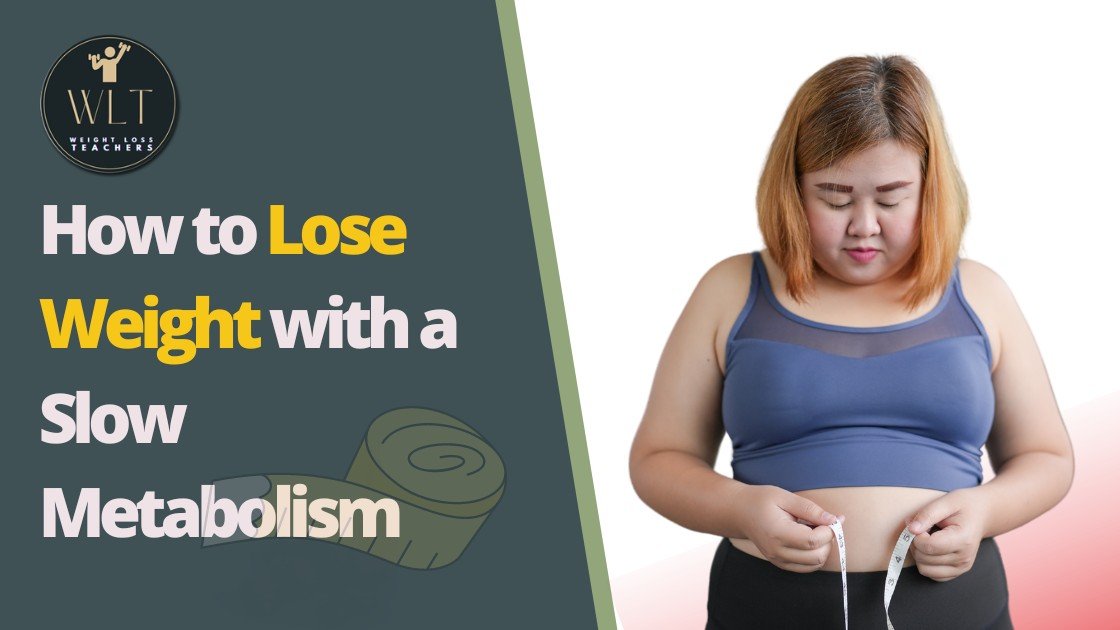
How to Lose Weight When You Have Slow Metabolism

Losing weight can be a daunting task for anyone, but it can be especially challenging for people with a slow metabolism. A slow metabolism can make it difficult to burn calories, and it can be frustrating to put in effort without seeing results.
Table of Contents
Introduction
However, it is still possible to lose weight with a slow metabolism. In this article, we will explore how to lose weight with a slow metabolism, including tips on diet, exercise, and lifestyle changes.

Understanding Metabolism

Before we dive into how to lose weight with a slow metabolism, it’s essential to understand what metabolism is and how it affects weight loss. Metabolism is the process by which your body converts food into energy. This energy is then used to fuel your body’s functions, including breathing, circulating blood, and maintaining body temperature. Your metabolism is influenced by several factors, including age, sex, genetics, and body composition.
Your basal metabolic rate (BMR) is the number of calories your body burns at rest to maintain essential functions. The BMR accounts for approximately 60 to 70 percent of the calories you burn in a day. The remaining calories are burned through physical activity and digestion.
If you have a slow metabolism, your body burns fewer calories at rest than someone with a higher metabolism. This means that you need fewer calories to maintain your weight. If you consume more calories than your body needs, you will gain weight.
Tips for Losing Weight with a Slow Metabolism

Now that we understand the basics of metabolism, let’s explore some practical tips for losing weight with a slow metabolism.
Track Your Calories
The key to losing weight is to create a calorie deficit, which means burning more calories than you consume. Tracking your calories can help you determine how many calories you’re consuming and ensure that you’re eating fewer calories than you’re burning. There are several apps and websites available that make it easy to track your calories. By keeping a record of your food intake, you can make informed decisions about your diet and adjust your calorie intake accordingly.
Eat a Balanced Diet
Eating a balanced diet is essential for weight loss, especially for people with a slow metabolism. A balanced diet should include lean protein, complex carbohydrates, and healthy fats. Protein is essential for building and maintaining muscle, which can help boost your metabolism. It also helps you feel full and satisfied, reducing the likelihood of overeating. Good sources of protein include lean meat, fish, poultry, eggs, beans, and legumes.
Complex carbohydrates, such as whole grains, fruits, and vegetables, provide energy and fiber to keep you feeling full. They are also nutrient-dense and can support overall health. Healthy fats such as those found in nuts, seeds, and avocados, can help you feel satisfied and provide essential nutrients. They also contribute to heart health.
By including a balance of these macronutrients in your diet, you can ensure that your body gets the necessary nutrients while managing your calorie intake.
Intermittent Fasting
Intermittent fasting (IF) is an eating pattern that involves cycling between periods of fasting and eating. It has gained popularity as a weight loss strategy and is known to offer various health benefits. During the fasting period, you restrict your calorie intake, allowing your body to tap into its fat stores for energy. Here’s a closer look at intermittent fasting and how it can be effective for weight loss with a slow metabolism.
What is Intermittent Fasting? Intermittent fasting involves dividing your day or week into fasting and eating windows. There are different fasting protocols, including:
- 16/8 Method: This method involves fasting for 16 hours and restricting your eating window to 8 hours each day.
- 5:2 Diet: This approach involves eating normally for five days of the week and significantly reducing calorie intake (around 500-600 calories) on the remaining two non-consecutive days.
- Alternate-Day Fasting: This method alternates between fasting days, where you consume very few calories or none at all, and regular eating days.
How Does Intermittent Fasting Help with Weight Loss?

Intermittent fasting can aid weight loss in several ways:
- Calorie Restriction: By limiting the time window for eating, you naturally consume fewer calories, which can create a calorie deficit necessary for weight loss.
- Increased Fat Burning: During the fasting period, your body depletes glycogen stores and starts using stored fat as a source of energy.
- Improved Insulin Sensitivity: Intermittent fasting can enhance insulin sensitivity, helping your body better regulate blood sugar levels and promote fat burning.
- Boosted Metabolism: Fasting stimulates the production of human growth hormone (HGH), which can increase metabolism and help preserve muscle mass.
It’s important to note that intermittent fasting may not be suitable for everyone, especially those with underlying health conditions. It’s best to consult with a healthcare professional before starting any fasting regimen.
Low Carb Diet:
A low carb diet is an eating approach that restricts carbohydrate intake while emphasizing protein and healthy fats. It has been widely recognized as an effective way to lose weight and improve overall health. Here’s what you need to know about a low carb diet and its benefits for weight loss with a slow metabolism.
What is a Low Carb Diet?

A low carb diet involves reducing your intake of high-carbohydrate foods such as grains, starchy vegetables, sugary treats, and processed foods. Instead, the focus is on consuming protein-rich foods, non-starchy vegetables, and healthy fats.
How Does a Low Carb Diet Help with Weight Loss?
A low carb diet can promote weight loss in the following ways:
- Reduced Insulin Levels: By limiting carb intake, you minimize blood sugar spikes and insulin release. This helps prevent excess storage of fat and promotes fat burning.
- Increased Satiety: Protein and healthy fats are more satiating than carbohydrates, helping you feel fuller for longer and reducing the likelihood of overeating.
- Enhanced Fat Burning: When carbohydrate intake is limited, your body shifts into a metabolic state called ketosis, where it primarily uses fat for fuel. This can lead to increased fat burning and weight loss.
- Stabilized Blood Sugar Levels: A low carb diet can help regulate blood sugar levels, reducing cravings and preventing energy crashes that often lead to unhealthy food choices.
It’s important to note that not all carbohydrates are equal, and the focus should be on reducing refined carbs and added sugars rather than completely eliminating all carbs. Additionally, individuals with certain medical conditions, such as diabetes, should work closely with healthcare professionals to ensure their carbohydrate intake aligns with their specific needs.
Increase Your Protein Intake
As mentioned earlier, protein is essential for building and maintaining muscle. When you have a slow metabolism, it’s even more crucial to preserve muscle mass because muscle burns more calories than fat. By increasing your protein intake, you can support muscle growth and help boost your metabolism.
Incorporate lean sources of protein into your meals and snacks. Choose options such as chicken breast, turkey, fish, tofu, eggs, and low-fat dairy products. If you’re following a vegetarian or vegan diet, you can opt for plant-based protein sources like legumes, quinoa, tempeh, and seitan. By including protein in each meal and snack, you can help regulate your appetite and promote weight loss.
Incorporate Strength Training
Strength training can help build muscle, which can boost your metabolism and help you burn more calories at rest. Many people with slow metabolisms shy away from strength training because they believe it will make them bulk up. However, that is a common misconception. Strength training with moderate weights and higher repetitions can help tone and define your muscles without adding excessive bulk.
You don’t need to lift heavy weights to see results; bodyweight exercises such as push-ups, squats, and lunges can be effective. These exercises engage multiple muscle groups and can be done anywhere, making them convenient for those who prefer to work out at home. Resistance bands and free weights can also be used to add resistance to your workouts.
Try to incorporate strength training exercises into your routine two to three times a week, allowing for rest days in between to allow your muscles to recover. As you build muscle, you will increase your metabolism, making it easier to lose weight.
Note: There might be affiliate links mentioned here. We may receive a commission if you purchase a product through an affiliate link. There is no additional charge for you. Please do your own research before making any online purchases.
Add Cardiovascular Exercise
Cardiovascular exercise, also known as aerobic exercise, is an essential component of any weight loss program. It helps you burn calories, improve your cardiovascular health, and boost your metabolism. Cardiovascular exercise can also increase your energy levels, improve mood, and reduce stress.
Choose activities that you enjoy and that fit your fitness level. It can be running, cycling, swimming, dancing, or any other form of continuous movement that raises your heart rate. Aim for at least 150 minutes of moderate-intensity exercise per week, or 75 minutes of high-intensity exercise per week. You can break down your workouts into smaller sessions throughout the week if that works better for your schedule.
Stay Hydrated
Drinking enough water is essential for weight loss, especially for people with a slow metabolism. Water helps flush toxins from your body, aids in digestion, and keeps you feeling full. Often, people mistake thirst for hunger and end up eating more than necessary. By staying hydrated, you can avoid unnecessary snacking and support your weight loss efforts.
Aim for at least eight glasses of water per day, or more if you’re exercising or in a hot climate. If you find plain water boring, you can infuse it with fruits, herbs, or a splash of citrus juice to add flavor. Herbal teas and unsweetened beverages like green tea and black coffee can also contribute to your daily fluid intake.
Get Enough Sleep
Getting enough sleep is essential for weight loss and overall health. Lack of sleep can disrupt your metabolism and increase your appetite, making it harder to stick to your diet. When you’re sleep-deprived, your body produces more ghrelin, the hormone that stimulates hunger, and less leptin, the hormone that signals fullness.
Aim for seven to nine hours of sleep per night, and try to maintain a consistent sleep schedule. Create a relaxing bedtime routine that includes activities like reading a book, taking a warm bath, or practicing relaxation techniques. Avoid electronic devices and stimulating activities close to bedtime, as they can interfere with your sleep quality.
Reduce Stress Stress can have a negative impact on your metabolism and make it harder to lose weight. When you’re stressed, your body produces cortisol, a hormone that promotes fat storage, particularly around the abdominal area. Stress can also increase your appetite and lead to emotional eating, where you turn to food for comfort or distraction.
Finding ways to manage stress is crucial for weight loss. Experiment with stress-relief techniques like meditation, yoga, deep breathing exercises, or engaging in hobbies and activities that you enjoy. Prioritize self-care and carve out time for relaxation and leisure. If you find that stress is overwhelming or persistent, consider seeking support from a mental health professional.
Avoid Crash Diets
Crash diets can be tempting, especially for people with a slow metabolism who may feel like they’re not seeing results. However, crash diets can be harmful to your health and can lead to weight gain in the long term. Many crash diets severely restrict calories or eliminate entire food groups, which can result in nutrient deficiencies and a slower metabolism.
Instead of opting for quick fixes, focus on making sustainable lifestyle changes that you can maintain over time. Emphasize portion control, balance, and variety in your meals. Gradually incorporate healthier food choices and habits into your routine, and allow yourself occasional indulgences in moderation. Remember, slow and steady progress is more sustainable and effective than rapid weight loss.
Be Patient
Weight loss can be a slow process, especially for people with a slow metabolism. It’s important to be patient and realistic with your expectations. Avoid comparing your progress to others or getting discouraged if you don’t see immediate results. Remember that each person’s weight loss journey is unique, and what works for one person may not work for another.
Stay consistent with your diet and exercise routine, and celebrate small victories along the way. Focus on non-scale victories, such as increased energy levels, improved mood, and better overall health. Keep in mind that sustainable weight loss is about creating healthy habits that you can maintain for a lifetime.
FAQs (Frequently Asked Questions)
Can I lose weight with a slow metabolism?
Yes, it is possible to lose weight with a slow metabolism. While a slow metabolism may make weight loss more challenging, it doesn’t make it impossible. By making appropriate dietary and lifestyle changes, you can create a calorie deficit and achieve weight loss.
How can I track my calorie intake effectively?
There are several apps and websites available that make it easy to track your calorie intake. These tools allow you to log your meals and provide nutritional information for a wide range of foods. Tracking your calories can help you become more aware of your eating habits and ensure that you’re consuming fewer calories than you’re burning.
What should I include in a balanced diet?
A balanced diet should include a variety of foods from different food groups. It should consist of lean protein sources such as poultry, fish, eggs, beans, and legumes. Complex carbohydrates like whole grains, fruits, and vegetables provide energy and fiber. Healthy fats found in nuts, seeds, and avocados are also important. Aim to have a colorful plate with a good mix of these food groups.
Why is protein important for weight loss with a slow metabolism?
Protein is essential for weight loss with a slow metabolism because it helps build and maintain muscle mass. Muscle is metabolically active and burns more calories at rest compared to fat. By including adequate protein in your diet, you can help preserve muscle mass and support a higher metabolic rate.
Do I need to lift heavy weights to boost my metabolism?
No, you don’t need to lift heavy weights to boost your metabolism. While heavy weightlifting can be effective, even bodyweight exercises like push-ups, squats, and lunges can help build muscle and increase your metabolic rate. The key is to challenge your muscles with resistance, regardless of the weight used.
How often should I do strength training exercises?
To see results, aim to incorporate strength training exercises into your routine two to three times a week. Allow for rest days in between to give your muscles time to recover and rebuild. Consistency is important for long-term progress, so find a schedule that works for you and stick to it.
What are some examples of cardiovascular exercises?
Cardiovascular exercises are any activities that raise your heart rate and keep it elevated for an extended period. Examples include running, jogging, cycling, swimming, dancing, and aerobic classes. Choose activities that you enjoy and that fit your fitness level to make them sustainable and enjoyable.
How much water should I drink for weight loss?
Aim to drink at least eight glasses of water per day, or more if you’re exercising or in a hot climate. However, individual hydration needs may vary depending on factors such as body size, activity level, and environmental conditions. Listen to your body and drink enough water to stay adequately hydrated throughout the day.
How does sleep affect weight loss?
Getting enough sleep is crucial for weight loss. Lack of sleep can disrupt your metabolism and increase your appetite. Aim for seven to nine hours of quality sleep per night. Establish a consistent sleep routine and create a sleep-friendly environment to promote better sleep hygiene.
What are some effective stress management techniques?
Managing stress is important for weight loss with a slow metabolism. Try relaxation techniques such as meditation, deep breathing exercises, or yoga. Engage in activities that you enjoy and that help you unwind. It’s also helpful to prioritize self-care, set boundaries, and seek support from loved ones or professionals if needed.
Are crash diets a good option for weight loss with a slow metabolism?
No, crash diets are not recommended for weight loss with a slow metabolism. They often involve severe calorie restriction, which can lead to nutrient deficiencies and a slower metabolism. Instead, focus on making sustainable lifestyle changes and adopting healthy habits that you can maintain in the long term.
How long does it take to see results with a slow metabolism?
The timeline for weight loss results can vary from person to person, including those with a slow metabolism. It’s important to be patient and consistent with your efforts. Healthy and sustainable weight loss is typically considered to be around 1-2 pounds per week. Remember, slow and steady progress is more sustainable and beneficial for long-term success.
How can I stay motivated during my weight loss journey?
Staying motivated can be challenging, but there are strategies you can use. Set realistic and achievable goals, both short-term and long-term. Celebrate non-scale victories such as increased energy levels or fitting into smaller clothes. Surround yourself with a support system of friends or family who can cheer you on. Find activities you enjoy and make them part of your routine to maintain interest and enjoyment. Lastly, be kind to yourself and practice self-compassion throughout the process.
Conclusion
Losing weight with a slow metabolism can be challenging, but it’s not impossible. By making sustainable lifestyle changes, such as tracking your calories, eating a balanced diet, and incorporating strength and cardiovascular exercise, you can lose weight and improve your overall health. Remember to be patient and consistent, and don’t get discouraged if you don’t see results right away. With time and effort, you can achieve your weight loss goals and feel confident in your body.
Approach your weight loss journey with kindness and self-compassion. Focus on nourishing your body, increasing your physical activity, and adopting healthy habits that support your overall well-being. Losing weight is not just about attaining a certain number on the scale; it’s about improving your health, increasing your energy levels, and enhancing your quality of life.
Remember that weight loss is a personal journey, and it’s important to listen to your body’s needs and prioritize your well-being above all else. If you have any underlying health conditions or concerns, it’s advisable to consult with a healthcare professional before making significant changes to your diet or exercise routine.
Believe in yourself, stay motivated, and stay committed to your goals. You have the power to make positive changes and create a healthier, happier you.
Disclaimer: The information provided in this article is for educational purposes only and should not be considered as a substitute for medical advice. Consult a healthcare professional before implementing any home remedies or making significant changes to your lifestyle.






